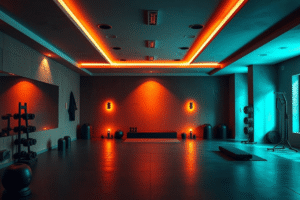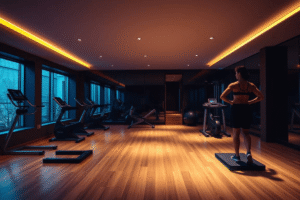The choice between a home gym and a public gym is a personal decision that depends on lifestyle, fitness goals, and preferences. For some, the privacy and convenience of a home gym are unbeatable, while others thrive on the variety, structure, and social interaction offered by a public gym. A home gym allows you to work out anytime without commuting or waiting for equipment. It’s a long-term investment tailored to your specific needs. Meanwhile, public gyms provide access to state-of-the-art equipment, professional trainers, and group classes that can enhance your fitness routine and keep you motivated.
Both options come with their unique advantages and challenges. Home gyms may save time and money in the long run, but they require initial setup costs and dedication to stay consistent. Public gyms, while offering a dynamic environment and expert guidance, may involve monthly memberships and peak-time crowds. Deciding between the two involves evaluating factors such as budget, space, time, and the kind of environment that helps you stay committed to your fitness goals. This comparison will help you weigh the benefits and drawbacks of both to determine which is the best fit for your lifestyle.
Convenience
A home gym provides unmatched convenience, allowing you to work out whenever it suits your schedule without the hassle of traveling. You have instant access to your equipment, eliminating the need to wait for machines or weights. Plus, you can exercise in the comfort of your own environment, customized to your preferences and needs.
In contrast, public gyms require commuting, which can be time-consuming and sometimes inconvenient. You must adhere to the gym’s operating hours, which might not always align with your routine. During busy times, waiting for equipment can be frustrating and disrupt your workout flow. While public gyms offer a wider variety of equipment and a sense of community, these drawbacks might affect your overall experience.
Ultimately, the choice depends on your priorities—whether you value convenience and control or prefer the resources and social interaction that public gyms provide.
Cost
Setting up a home gym requires an initial investment. Buying equipment can be expensive. However, it is a one-time cost. There are no monthly fees or transportation expenses.
Public gyms usually charge monthly or yearly fees. Over time, these costs add up. Some gyms have hidden fees for special classes or facilities.
Variety of Equipment
Public gyms offer a wide range of equipment. They provide machines for strength training, cardio, and flexibility. You can try different exercises without buying new equipment.
A home gym may have limited equipment. Purchasing various machines can be costly and require space. However, you can choose the equipment you use the most.
Privacy
A home gym ensures complete privacy, allowing you to exercise without distractions or interruptions. You can work out in a judgment-free zone, free from the pressure or comparisons that might arise in a shared space. This also means you can wear whatever makes you feel comfortable without worrying about others’ opinions.
On the other hand, public gyms offer limited privacy. They are often crowded, with people exercising around you. This environment can make some individuals feel self-conscious or uncomfortable while working out. While public gyms provide a sense of community, they may not offer the same level of personal comfort and focus that a home gym does. Ultimately, choosing between a home gym and a public gym depends on how much you value privacy and a distraction-free environment versus access to a shared fitness community and resources.
Motivation
A public gym can be a great source of motivation. Watching others exercise and seeing their dedication can inspire you to push your limits. Many gyms also provide group classes and personal trainers that create a structured and engaging environment, encouraging consistency and helping you stay on track with your fitness goals.
In contrast, staying motivated at home can be more challenging. The familiar surroundings of home often come with distractions like television, family responsibilities, or work tasks. Without external encouragement or a set schedule, it’s easy to lose focus. Maintaining a consistent workout routine at home requires strong self-discipline and determination to overcome these distractions and stay committed to your fitness journey.
At home, you have full control over the cleanliness of your gym. You can maintain hygiene standards that meet your preferences and ensure a safe, sanitary workout environment. There’s no need to share equipment with others, reducing the risk of exposure to germs or illnesses.
In contrast, public gyms are shared spaces where equipment is used by multiple people throughout the day. Despite regular cleaning measures, the high foot traffic increases the chances of germs spreading. For some, this can be a concern, especially during peak hours when machines and weights are frequently in use.
Social Interaction
Public gyms provide a vibrant social environment where you can meet new people and connect with like-minded individuals. The shared space often fosters friendships and offers a sense of community. For many, the social aspect of working out with others adds motivation and enjoyment to their fitness journey.
In contrast, a home gym offers solitude, which can sometimes feel isolating. Without the presence of others, there’s no opportunity for casual interactions or shared energy. For those who thrive on the camaraderie of a group setting, a home gym may lack the stimulating atmosphere of a public fitness space.
Customization
A home gym offers full customization to suit your unique preferences. You can select equipment that aligns with your fitness goals, set the lighting to your liking, and play your favorite music for motivation. Every aspect of the space can be tailored to create an environment that feels personal and comfortable.
On the other hand, public gyms provide a standardized setup. Equipment and layout are prearranged, leaving little room for personal preferences. Music, lighting, and rules are set by the gym, requiring you to adapt to the shared environment. Customization is limited, which may not cater to everyone’s needs.
Public gyms provide the advantage of having trainers readily available. These professionals can guide you with tailored workout routines, proper techniques, and personalized diet plans. For beginners, this hands-on support can be invaluable in building confidence and achieving fitness goals effectively.
In contrast, a home gym lacks immediate access to expert guidance. Without trainers on-site, you may need to depend on online tutorials, fitness apps, or invest in hiring a personal trainer for one-on-one sessions. This limitation can make it challenging to ensure proper form and progress for those new to fitness.
Conclusion
Choosing between a home gym and a public gym ultimately depends on your personal preferences, fitness goals, and lifestyle. A home gym offers unmatched convenience, privacy, and long-term cost efficiency, making it ideal for those who value flexibility and a personalized workout environment. On the other hand, a public gym provides access to a wide range of equipment, professional guidance, and the motivation that comes from being in a fitness-focused community.
Both options have their advantages and limitations, and there’s no one-size-fits-all solution. If you prefer the social aspect and professional resources, a public gym may be your best bet. However, if you prioritize flexibility and avoiding crowds, a home gym is an excellent alternative. In the end, the best gym is the one that aligns with your routine and keeps you consistent in achieving your fitness goals. Choose what works for you and stay committed!
Want more tips on home workouts, gym gear, and fitness motivation?
Subscribe to our free newsletter and get helpful fitness insights delivered straight to your inbox—perfect for staying on track wherever you train!











One comment
Experten gehen davon aus, dass anonyme Zahlungen in Casinos mit deutscher Lizenz nicht möglich sein werden. Für deutsche Spieler
gibt es zurzeit noch viele Anbieter, die keine Spielpause erzwingen. Da der deutsche Staat noch
keine Lizenzen für Online Glücksspiel-Anbieter vergeben hat,
findest du als Spieler in fast allen Casinos Slotmaschinen ohne strenge Einsatzlimits.
In Online Casinos mit deutscher Lizenz wird künftig eine Steuerabgabe von 5,
3 % auf alle Einsätze fällig. Wir empfehlen daher,
Casinos ohne deutsche Lizenz vor der Anmeldung zu recherchieren und dazu Expertentests
wie hier auf Spielautomaten.de zu nutzen.
Der Willkommensbonus von 100 % bis zu 500 € mit 200 Freispielen plus 1 Bonus Crab ermöglicht einen starken Einstieg.
Die meisten hängen mit den überstrengen Regulierungen des deutschen Marktes zusammen – andere wiederum
schlicht mit größeren Boni und einer größeren Spielauswahl.
Jedes Casino hat eine Bewertung von bis zu fünf Sternen erhalten, basierend auf spielerorientierten Features wie Bonusangeboten, Spielauswahl und Benutzerfreundlichkeit.
Fast täglich können Freispiele mit Einzahlung genutzt werden.
Ist die Vorgabe erfüllt, erhalten Sie die Freispiele gutgeschrieben. Die
Gratis Spins erfordern dann einen gewissen Mindestspieleinsatz
als Qualifikation. Trotzdem findet man im ein oder anderen Online Casino ohne deutsche Lizenz gelegentlich exklusive Bonusaktionen ohne Einzahlung.
References:
https://online-spielhallen.de/beste-deutsche-online-casinos-experten-test/